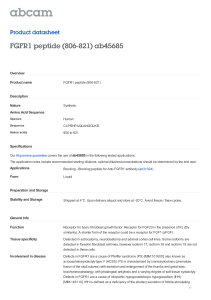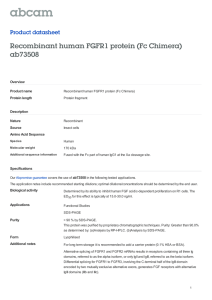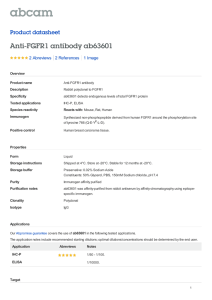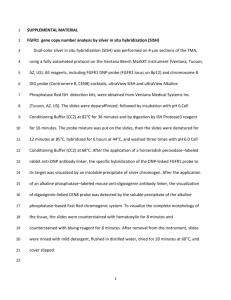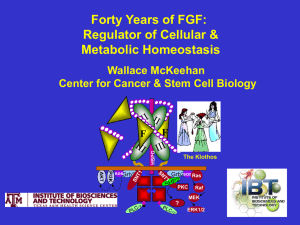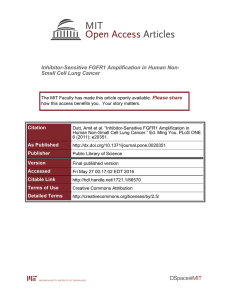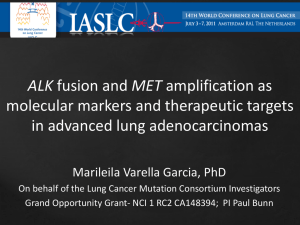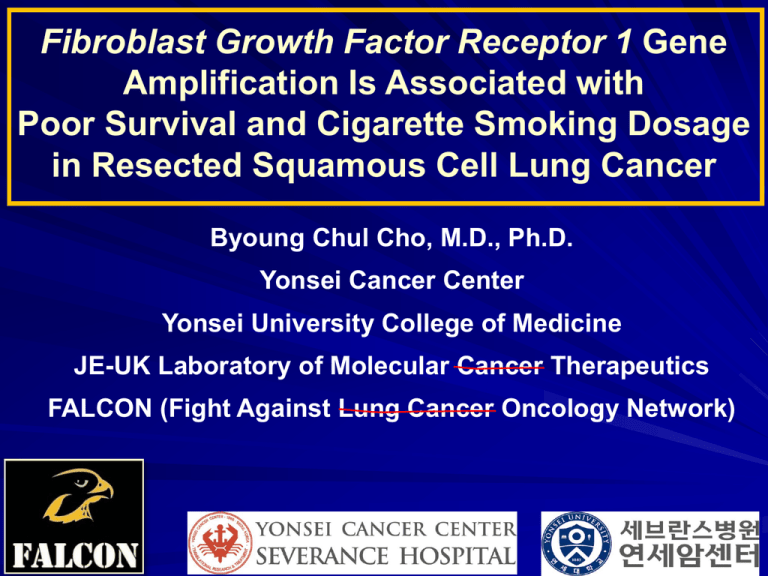
Fibroblast Growth Factor Receptor 1 Gene
Amplification Is Associated with
Poor Survival and Cigarette Smoking Dosage
in Resected Squamous Cell Lung Cancer
Byoung Chul Cho, M.D., Ph.D.
Yonsei Cancer Center
Yonsei University College of Medicine
JE-UK Laboratory of Molecular Cancer Therapeutics
FALCON (Fight Against Lung Cancer Oncology Network)
Lung Cancer Mutation Consortium
Incidence of Driver Mutations in Adenocarcinoma
ROS1
Mutation found in 54% (280/516) of
tumors completely tested (CI 50-59%)
Kris et al ASCO 2011
Squamous Cell Carcinoma of Lung
Lung squamous cell carcinoma (SqCC) accounts for ~30%
of non-small cell lung cancer
~90% are male smokers
(Korean Cancer Registry)
Despite advances in personalized
treatment of adenocarcinoma,
effective targeted therapies for
SqCC has remained elusive
Currently, lung SqCC lacks any druggable target
Frequencies of Potential Driver Mutations in
Lung Squamous Cell Carcinoma
Mutation
Frequency (%)
EGFR
<5
ALK
<5
HER2
0
BRAF
0
KRAS
<5
PIK3CA
<5
AKT1
<5
MAP2K1
0
MET
<5
~70%
unknown
Lancet oncol 2011;12:175
FGFR1 is Amplified in Lung Squamous
Cell Carcinoma
By FISH, high FGFR1 amplification (≥ 9 copies): 22% (34/153)
8p.12
Weiss J. Sci Transl Med 2010
FGFR1 amplifications are associated
with FGFR inhibitor activity
Weiss J. Sci Transl Med 2010
Study Purpose
To investigate the frequency and the
prognostic impact of FGFR1 amplification
in surgically resected lung SqCC
To evaluate the association between
smoking does and FGFR1-amplification
Patient and Method
SqCC patients that underwent radical resection of a
primary lung cancer at Severance Hospital between
1998 and 2009.
Selection criteria (n= 262): availability of tumor
tissue from the primary lung cancer, smoking-data,
and survival data
Construct a tissue-microarray with 2-mm diameter
cores (3 cores per tumor)
Gene Copy Number
FGFR1 FISH assay was performed on the tissuemicroarrays using FGFR1-probe that hybridizes to
the band 8p12-8p11.23 with Spectrum Orange (red)
and CEP 8 with Spectrum Green (Abbott Molecular®)
Prespecified Criteria1
“high-amplification” FGFR1 copy number ≥ 9
“low-amplification” FGFR1 copy number >2 or <9
“disomy” FGFR1 copy number = 2
1Weiss
J et al. Sci Transl Med 2010
FGFR1 protein & mRNA Expression
IHC analysis was performed using FGFR1 Ab
(Epitomics, Burlingame, CA)
Only clear membranous staining of the tumor cells was
considered positive and cytoplasmic or granular staining
was considered negative or trace
Scoring system (0-400): % of positive tumor cells (0% to
100%) X dominant staining pattern (1: negative or trace,
2: weak, 3: moderate, 4: intense)
mRNA expression analysis was performed by
QuantiGene Reagent Systems in FFPE tissue
samples
Patient characteristics according to FGFR1 gene amplification by FISH
FGFR1 IHC staining & Gene Copy Number by FISH
34 (13%)
105 (40.1%)
123 (46.9%)
Association between FGFR1 GCN and
FGFR1 protein & mRNA Expression
FGFR1 Amplification Is Associated with Poor
Survival in Resected Lung SqCC Patients
FGFR1 high amp
FGFR1 high amp
Kim HR, Soo RA, Cho BC. J Clin Oncol 2012
Multivariate Survival Analyses
Variable
Category
Disease-free survival
HR
Sex
Female vs.
95% CI
P
Overall survival
HR
95% CI
P
0.68 0.26-1.74 0.42
0.70 0.27-1.79 0.46
male
Pathologic stage
III vs. I+II
2.24 1.45-3.45 <0.0001
2.78 1.76-4.38 <0.0001
Smoking
Smoker vs.
1.60 0.84-3.05 0.15
1.35 0.70-2.58 0.35
never smoker
Adjuvant therapy
Yes vs. no
1.13 0.74-1.73 0.56
1.08 0.68-1.72 0.71
FGFR1 FISH
FGFR1 amp+ vs
2.24 1.45-3.45 <0.001
1.83 1.15-2.89 0.01
FGFR1 amp-
Treatment outcome to EGFR-TKI according
to FGFR1 Amplification
Independent dataset of unresectable, previously treated lung SqCC (N= 47)
FGFR1 Amplification is a Smokingassociated Oncogenic Mutation
P value was tested by χ2 test for linear trend
Kim HR, Soo RA, Cho BC. J Clin Oncol 2012
Intratumoral Heterogeneity?
Whole tissue section FISH in 51 randomly selected tumors
(31 high FGFR1-amp, 10 low FGFR1-amp and 10 disomy tumors)
Summary of Whole Tissue Section FISH
Homogenous FGFR1 distribution in high amplified tumors
- at least 80% of nuclei per area exhibited ≥ 9 copies of FGFR1
Majority of areas displayed low amplified FGFR1 signals In
low amplified tumors
Two FGFR1 signals were homogenously distributed in
disomy cases
No FGFR1 amplification in peritumoral normal tissue
High correlation of FGFR1 GCN between primary & metastatic
lesion1
FGFR1 amplification may be involved not in early
tumorigenesis, but in early disease progression
1Friederike
Goeke et al. Chest Apr 12, 2012
Conclusion: FGFR1 AmplificationA New “Druggable” Target in SqCC
The first high-frequency (13%) therapeutic target of
smoking-associated SqCC
FGFR1 amplification induced a strong FGFR1
dependency in FGFR1 amplified SqCC
FGFR1 amplification is a negative prognostic factor
in resected lung SqCC
FGFR1-amplification is associated with cigarettesmoking in a dose-dependent manner
Strongly implies that FGFR1-amplification is an
oncogenic-aberration caused by tobacco-carcinogen

